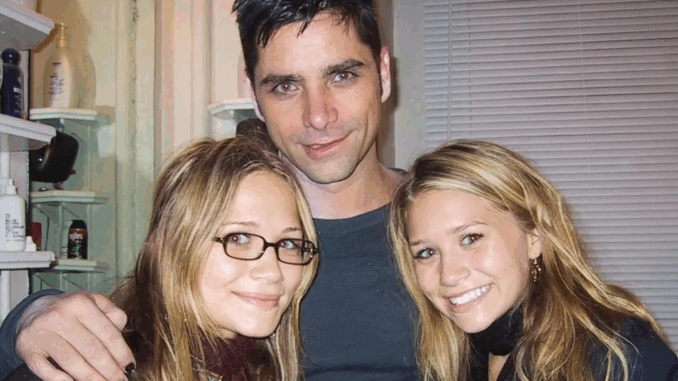
Setting the Scene: The Calm Before the Storm
Picture this: A brand‑new family comedy called Full House is about to start filming. The cast, including John Stamos, gathers nervously for the first table read. They’re about to test the jokes, the characters, the chemistry… and hopefully produce sitcom gold.
John Stamos Is Ready for His Spotlight
John Stamos was already a familiar face. He had a smoldering smile, acting credits, and expected to shiny in the ensemble. After all, he was playing Jesse—a cool rock ‘n’ roller, the sex symbol of the show. He was fully prepared to own the room.
Then A 5‑Year‑Old Took Over: Jodie Sweetin
During the first table read, Jodie Sweetin—who played Stephanie Tanner—opened her mouth to deliver a simple line. But that line didn’t land—it exploded. The room went from polite chuckles to full‐on, tears‑streaming laughter.
Jodie wasn’t just cute. She was hilarious. Natural. Timing gold. And in that moment, she made the audience, the cast, and yes—John Stamos—look small.
Stamos’s Ego Took a Hit
John sat back in his chair, watching Jodie get reaction after reaction. Writer after producer laughed. Not at his lines—at hers. He could feel the spotlight shifting.
Moments later, he quietly slipped out. He walked to the lobby, dialed his agent, and said, “Get me the fk off this show.”**
Yes—straight up quitting before the cameras even rolled.
The Fallout: Ego vs. Ensemble
That decision wasn’t about being disrespectful. It was about ego crashing into reality. John expected to be the star. Instead, a 5‑year‑old was blowing him out of the water at the first table read.
It was a rude wake‑up call—especially for someone ready to lead the show.
He Also Wanted the Babies Out
In the following days, filming with the twin baby Olsens who played Michelle became another challenge. Crying, fussing, unpredictable babies—makes every setup a headache.
Frustration built. John asked the production team to fire them. Yes, fire the toddlers. Who wouldn’t want that to be easy, right?
Instead, the twins were briefly replaced—and then rehired when the replacements were worse on set.
Changing Perspective: What He Learned Fast
Eventually, John cooled off. He realized the show would be about family—and that family included:
-
A brilliant little comedic force (Jodie)
-
A pair of unpredictable twins
-
That rock‑star persona he’d embody
He discovered the power wasn’t in standing out. It was in contributing.
A Legendary Reunion: Fuller House Showed Long‑Term Respect
Years later, when Fuller House premiered, that same Jodie was back—grown up, funny, and beloved. John returned too, with fresh humility, humor, and respect. The table‑read moment became a fun anecdote, not a hurtful one.
Why This Moment Matters
-
It shows actors are human. Even seasoned pros can feel jealousy or struggle with expectations.
-
It reminds us how great TV is made. Not by individual stars—but by ensemble commitment.
-
It reflects humility. John could’ve left—but he stayed, and helped build something legendary.
Was It Just Ego—or Something Deeper?
Sure, it could’ve been sour grapes. But it also showed a moment of insecurity—a talented actor thinking, “Wait—am I not shining anymore?”
In a show full of kids, funny quips, and heart‑warming lessons, that insecurity had nowhere to hide.
The Bigger Picture: Ensemble over Ego
Full House crashed into families’ hearts not through one person—but through its ensemble strength. Dads, uncles, kids, friends—all sharing love and lessons.
John Stamos’s initial meltdown didn’t ruin it. It nearly did—but his willingness to stay and embrace the ensemble saved it.
Stamos’s Take Today: Reflecting with Humor
John Stamos has shared multiple times—on talk shows and podcasts—how funny the story feels in retrospect. He laughs about it now. He admits he was a jerk in that moment.
But he also admits that that trip to the phone booth was his own vanity talk. And owning that made him better both on screen and off.
The Joy That Emerged From the Chaos
What started as hurt pride ended up becoming part of the show’s success story. Had John left, we’d never have seen Jesse’s growth from rockstar to doting uncle. Or the Malibu Baj-a-Negas. Or him singing with Michelle.
Instead, he stayed—and helped create TV magic.
The Takeaway for Viewers and Storytellers
Actors are human. Shows are emotional ecosystems. And moments of conflict—behind the scenes—can become artful, funny, and transformative—in real life and on screen.
John Stamos’s arc on Full House reflects that journey: from putting himself first, to contributing to something eternal.
Conclusion: Ego Bronzes—But Family Endures
John Stamos’s desire to leave Full House might feel shocking. But it also feels real. A star expecting success at first table read—only to be dazzled (and upstaged) by a precocious kid.
That moment of ego gave way to a long‑lasting legacy. And the lesson? Sometimes you have to get your heartbroken, humbled, and surprised… to contribute to something bigger than yourself.
5 Unique FAQs
1. Did John Stamos really try to quit ‘Full House’?
Yes—right after the first table read, when Jodie Sweetin stole the show with her delivery.
2. Who did he blame next?
He asked for the Olsen twins who played Michelle to be fired—but they were rehired.
3. Was it all ego, or was he stressed?
Both. He felt overshadowed. He was dealing with the unpredictability of toddlers on set. It was a rough collision of pride and production challenges.
4. Did John regret his meltdown?
Quickly. He recognized the ensemble’s value, embraced it, and helped build the show’s emotional core.
5. Does he still talk about it?
Yes! Stamos often recounts the story with humor, humility, and affection—reminding everyone how close he came to quitting something legendary.
